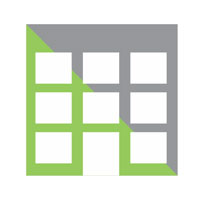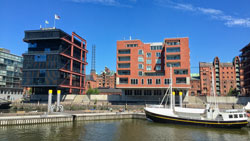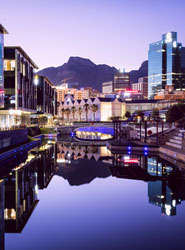 |
Most all of us, to one degree or another, understand what “Green” architecture is. We know there are products that take less from the planet, reduce energy use and create healthier environments in our homes and buildings. We know we can do our part, wherever we are, to reduce, reuse, recycle. We know our buildings can be designed and built in ways that are better for the planet and better for us. |
The term “green building” actually has a very specific definition - written by the
Office of the Federal Environmental Executive as “the practice of 1) increasing the efficiency with which buildings and their sites use energy, water, and materials, and 2) reducing building impacts on human health and the environment, through better siting, design, construction, operation, maintenance, and removal — the complete building life cycle”
What we call green architecture today grew out of the “eco-awareness” movement begun in the 1960’s, really hitting the mainstream in the 1970’s. Some of the early pioneers in this movement were American social philosopher and architecture critic Lewis Mumford, Scottish landscape architect Ian McHarg and British scientist James Lovelock.
Mumford, worried about energy consumption and wrote:
“The solution of the energy crisis would seem simple: transform solar energy via plants and produce enough food power and manpower in forms that would eliminate the wastes and perversions of power demanded by our high-energy technology. In short, plant, eat, and work!”
McHarg, in his acclaimed 1969 book
Design With Nature, described an ecologically sound approach to planning and designing communities. He had a lot to say about the environment, including:
“Let us green the earth, restore the earth, heal the earth….” and “The most important issue of the 21st century will be the condition of the global environment.”
Lovelock went so far as to define the entire planet as a single unified organism, continuously maintaining itself. He described this in his “
GAIA hypothesis” as:
“a complex entity involving the Earth’s biosphere, atmosphere, oceans, and soil; the totality constituting a feedback or cybernetic system which seeks an optimal physical and chemical environment for life on this planet.”
So there is much history, much spoken and a fair amount done over these years, in terms of green architecture. But ….. is there such a thing as “Blue” architecture?
Blue Architecture?
Yes, we know architecture can be green, but let’s consider why architecture can also be blue. The planet’s surface is mostly water, after all! Sea levels are rising, so the surface of the planet is becoming even more water. The edge of land and sea has never been fixed, but these days this “edge” is very unfixed and changing faster each year.
The ecosystems where land and sea meet, wetlands and other living buffers, are under intense pressures. Many are not surviving. Some have shifted and changed, as waters rise.
Unprecedented weather systems are causing increased amounts of damage. We’ve known for a long time that it’s risky to build at the water’s edge. And we’ve known that old planning and construction methods made damage even more likely.
In terms of land and water, climate change means loss of habitat, loss of property, even loss of life. The problems are urgent ones and, whether or not we’ve reached a tipping point, the impacts are felt the most, by those with the least ability to affect their conditions.
Maybe we’ll wake up soon and make significant changes in how we live on this planet. In the meantime, our planet is not only becoming hotter, but bluer, as well. Ice melts, waters rise, less land exists … Sure, much of the land mass is drier, not wetter, as temps rise, but the edges of continents (where towns and cities are the densest) are loosing ground, islands are even disappearing as water washes over them. Our built world is realizing the need to respond with a 21st century version of “eco-awareness” - where green also is blue.
Blue Architecture is architecture at this edge of land and sea, where dry ground is more and more often wet, where streets can flood, where water even becomes the main transportation route. It accounts for rising waters, more frequent flooding and larger storm surges. It recognizes what exists today may need to be moved away tomorrow and what exists tomorrow must be resilient and adaptable.
Blue architecture also shapes how we can be water-smart, dealing with more water in some places, but also dealing with less in other places. There’s a new report out by the Urban Land Institute called “
Water Wise: Strategies for Drought-Resilient Development”, presenting water-saving measures and policy recommendations for land use and water management.
So what is Blue Architecture, actually?
 |
Put simply, it’s water-based architecture-designed to protect from water, coexist with water and even interact with water. It treats water just like any other surface, or environment. |
It’s a building with a ground level that can be wet and not be destroyed, or a ground floor with dams that raise when needed to hold water back and disappear otherwise. It’s a home, floating on the water with a connection to land. It’s a park building on sleds for foundations, so the entire structure can be moved closer to or further from the water. It’s a utility building that creates power from the movement of water under and through it. It’s an apartment building that uses reverse osmosis systems to create a micro-source of potable water for its occupants. It’s a desert building that uses atmospheric water generation as its source of water. It’s the wet version of biomimicry. Blue architecture is an approach to planning, design and construction that recognizes just how much all life on this planet depends on water.
And, it’s part of a bigger whole - one that recognizes environment, society and economy as interdependent. It is a critical element of a “Blue Economy” - what the
World Bank says is the "sustainable use of ocean resources for economic growth, improved livelihoods, and jobs while preserving the health of ocean ecosystem." and the
European Commission defines as "All economic activities related to oceans, seas and coasts.
AltaSea, a marine science research campus at the Port of Los Angeles, says the Blue Economy looks to the ocean to solve many of the world’s problems, from food insecurity to climate change, enhancing careers that include ocean engineers, marine ecologists, earth scientists, marine energy specialists, policy analysts and communications specialists. I would add architects and engineers to this list! Recently, I spoke with Terry Tamminen, President/CEO of AltaSea at the Port of Los Angeles.
Terry and his organization have much to say about the Blue Economy and are doing great work in this area. Please click this
link to hear our recent
Spotlight interview!
What’s the importance of all of this green architecture and now blue architecture? How does it all affect our lives and what do we do about it? Well, we can find the answers to questions like these in many places, when it comes to green architecture. But, for blue architecture, look no further than your own water choices, or where you live, what your community is doing about water. If you’re in the business of designing or building, then add water into your conversations, your design programs, your materials and systems.
 |
Some of us will see less water in time, others will see more, but all of us are here because of it. Two quotes come to mind:
“When the well’s dry, we know the worth of water” - Benjamin Franklin
“We forget that the water cycle and the life cycle are one.” – Jacques Cousteau
|